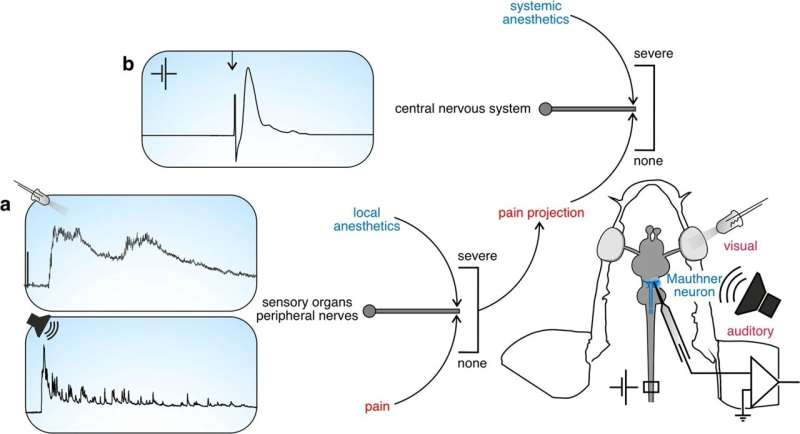Brief overview of how the Mauthner neuron can be used to examine the mode of action of anesthetics. Intracellular in vivo recording in the Mauthner neuron (MN) of the goldfish provides a comprehensive and rapid assay of targets an anesthetic can act on. a Its function as a command neuron for life-saving escapes requires the MN to faithfully process information forwarded from almost all senses. So, recording of postsynaptic potentials after sensory stimulation (e.g., visual or acoustic) can reveal whether the anesthetic affects different sensory organs directly, the transmission of sensory information to the MN or the processing within the MN. b The systemic effect an anesthetic can have on central neurons by affecting ion channels and the generation and axonal conduction of action potentials can be studied by antidromically activating the Mauthner axon. Credit: Communications Biology (2023). DOI: 10.1038/s42003-023-04695-4
Isoeugenol is a fragrance contained in plants that is very commonly used as an anesthetic in fish farming facilities and aquaculture. A research team at the Department of Animal Physiology at the University of Bayreuth has now investigated the mode of action of isoeugenol in fish.
The study, published in Communications Biology, shows how and in what doses the active ingredient affects the perception and transmission of sensory stimuli and their processing in the brain of fish. The findings enable the informed and more targeted application of isoeugenol anesthesia in the interest of animal welfare.
The Mauthner cells in the brains of fish process all the information available to the fish on the basis of their sensory systems. Previous studies at the Department of Animal Physiology have shown that they are an almost ideal target for determining the effects of an anesthetic on fish in detail.
The new study follows on from this: The study focused on whether isoeugenol impairs the sensory systems of fish or blocks the transmission of sensory information taken up from the environment to the brain, or whether it prevents the processing of this information in the brain.
"Isoeugenol is a very effective anesthetic in fish, used for example during the treatment of fish against parasites. However, it was previously unclear what the anesthetic effect of isoeugenol is based on. We were able to demonstrate that isoeugenol mainly affects the sensory systems of fish, i.e. it prevents them from taking up information from the environment. Even comparatively small amounts of isoeugenol massively reduce vision, significantly higher doses are required to switch off hearing. However, all sensory systems recover quickly and completely after isoeugenol administration," says first author Dr. Peter Machnik, a research associate at the Department of Animal Physiology.
The new findings do not support the assumption that isoeugenol blocks sodium channels in the central nervous system of fish and thus prevents the processing of sensory information in the brain. Primarily, the active ingredient acts as a local anesthetic. Only when high doses were administered did the Bayreuth researchers also detect an effect on central neurons, but this effect was not reconciled with the idea of a blockade of sodium channels.
The authors of the study consider isoeugenol to be an anesthetic that, when used in an aimed manner, is suitable for reducing stress and pain in fish, both in scientific research and in fish farming. It has not only an anesthetic but also a sedative effect on the fish.
However, isoeugenol has proven unsuitable as an anesthetic during invasive procedures or for calming fish while their sensory systems are being studied, for example in studies on sensory systems—if only because the present study has shown that the same dosage has very different effects on different fish and the desired reducing effect is not always guaranteed.
"We recently presented the study at the meeting of the German Neuroscience Society in Göttingen. Our results on the effects of isoeugenol met with a great deal of scientific interest. They were seen as a valuable contribution to future animal welfare, because isoeugenol is now used in many fish farms worldwide without precise knowledge of its effects and of the necessary dosages," says Prof. Dr. Stefan Schuster, Chair of Animal Physiology at the University of Bayreuth.
More information: Peter Machnik et al, Recordings in an integrating central neuron reveal the mode of action of isoeugenol, Communications Biology (2023). DOI: 10.1038/s42003-023-04695-4
Journal information: Communications Biology
Provided by University of Bayreuth
























